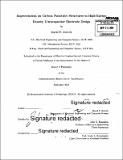| dc.contributor.advisor | John G. Kassakian. | en_US |
| dc.contributor.author | Jenicek, David P. (David Pierre) | en_US |
| dc.contributor.other | Massachusetts Institute of Technology. Department of Electrical Engineering and Computer Science. | en_US |
| dc.date.accessioned | 2015-01-20T17:59:13Z | |
| dc.date.available | 2015-01-20T17:59:13Z | |
| dc.date.copyright | 2014 | en_US |
| dc.date.issued | 2014 | en_US |
| dc.identifier.uri | http://hdl.handle.net/1721.1/93063 | |
| dc.description | Thesis: Ph. D., Massachusetts Institute of Technology, Department of Electrical Engineering and Computer Science, 2014. | en_US |
| dc.description | Cataloged from PDF version of thesis. | en_US |
| dc.description | Includes bibliographical references (pages 125-134). | en_US |
| dc.description.abstract | Ultracapacitors are a class of electrochemical energy storage device that is gaining significant industrial traction due to their high charging rate and cycle life compared to rechargeable batteries; however, they store significantly less energy on a per-volume basis. The quest to find an electrode material that could bridge the gap between energy and power density in electrochemical storage devices has been the object of significant industrial and academic research efforts over the past two decades. One promising material, and the focus of this research, is a dense forest of vertically-aligned carbon nanotubes (CNTs). Previous work at MIT has projected that such structures could augment the energy density of ultracapacitors by a factor of five over existing packaged devices. This thesis is an investigation into the electrode fabrication techniques that approach this goal. Carbon nanotube forests are synthesized on thin tungsten substrates by chemical vapor deposition (CVD) to form porous, high-surface area electrodes. We demonstrate that the capacitance of CNT electrodes is very highly correlated to the morphological and geometrical features of the CNT forest. These features, such as areal density, mean nanotube diameter, and nanotube length, are shown to be tunable and a series of pre- and post-treatment steps are examined to achieve two specific goals: an increased electrode specific surface area (m²/cm³ ) and an improved differential capacitance ([mu]F/cm² of CNT surface). Substrates are prepared for CVD by depositing a thin sub-nanometer film of catalytically active material via magnetron sputtering. Electrodes we fabricated using this conventional technique did not exhibit a specific surface area large enough to provide the high capacitance required for energy-dense electrodes. Numerous enhancements to this "standard" procedure are explored, such as varying the material deposition rate and substrate temperature, adding reactive gases during deposition, and depositing multiple catalyst layers. A nearly 5x increase in specific surface area is achieved. Furthermore, the surface properties of as-grown CNTs are modified by exposure to reactive plasmas and other high-energy environments; these treatments result in over a 2 x increase in differential capacitance. Compounded, the fabrication methods explored in this thesis provide a nearly 10x performance increase over conventional CNT electrodes, with a demonstrated cell capacitance of 56 mF using two 1 cm² electrodes. Finally, some key arguments are presented that assess the commercial viability of CNT-based ultracapacitors. | en_US |
| dc.description.statementofresponsibility | by David P. Jenicek. | en_US |
| dc.format.extent | 142 pages | en_US |
| dc.language.iso | eng | en_US |
| dc.publisher | Massachusetts Institute of Technology | en_US |
| dc.rights | M.I.T. theses are protected by copyright. They may be viewed from this source for any purpose, but reproduction or distribution in any format is prohibited without written permission. See provided URL for inquiries about permission. | en_US |
| dc.rights.uri | http://dspace.mit.edu/handle/1721.1/7582 | en_US |
| dc.subject | Electrical Engineering and Computer Science. | en_US |
| dc.title | Improvements on carbon nanotube structures in high-energy density ultracapacitor electrode design | en_US |
| dc.type | Thesis | en_US |
| dc.description.degree | Ph. D. | en_US |
| dc.contributor.department | Massachusetts Institute of Technology. Department of Electrical Engineering and Computer Science | |
| dc.identifier.oclc | 899998680 | en_US |
